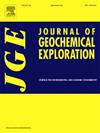胶东半岛多期热液蚀变与造山带金矿异常富集关系的磷灰石影像研究
IF 3.4
2区 地球科学
Q1 GEOCHEMISTRY & GEOPHYSICS
引用次数: 0
摘要
造山带金矿占全球黄金资源的30%。了解热液蚀变对金富集的贡献,对认识金的异常富集过程,提高找矿效率具有重要意义。巨大的胶东金矿省是世界级的金矿化地区,也是中国最大的黄金产地(金储量达5760 t),但胶东多期热液蚀变与金矿化的关系尚不明确。本文将王儿山金矿磷灰石的阴极发光和元素分析应用于不同蚀变组合中,追踪多期热液蚀变,并评价其对造山带金矿床金富集的贡献。根据岩石学特征,确定了4种类型的磷灰石:未蚀变磷灰石(Ap1)、钾长石蚀变磷灰石(Ap2)、赤铁矿-金红石蚀变磷灰石(Ap3)和与金矿化直接相关的黄铁矿-绢云母-石英蚀变磷灰石(Ap4)。钾长石蚀变磷灰石(Ap2)的地球化学特征与岩浆磷灰石(Ap1)相似,流体富含Ca、P、ree,与还原环境下的岩浆分异有关。钾长石蚀变与中生代岩浆作用有成因关系,但与金的富集无直接关系。赤铁矿-金红石蚀变磷灰石(Ap3)表现出高氧逸度、富F、贫稀土的特征,与造山带金矿热液磷灰石的化学性质不同。结合铁、钛的赋赋性和赤铁矿—金红石蚀变过程的广泛空间分布,推测成矿前成矿物质的活化和富集,这也可能是胶东地区金赋赋量高的潜在原因。在赤铁矿—金红石蚀变(Ap3)到黄铁矿—绢云母—石英蚀变(Ap4)过程中,流体温度、压力和氧逸度均有所降低。黄铁矿-绢云母-石英蚀变(Ap4)磷灰石的S、Cl和Na含量高于黄铁矿-绢云母-石英蚀变(Ap4)磷灰石,表明挥发性物质参与了成矿过程。Ap3磷灰石中的赤铁矿-金红石蚀变晕形成于成矿前。赤铁矿-金红石蚀变是造山带金矿成矿的重要标志。本文章由计算机程序翻译,如有差异,请以英文原文为准。

Apatite as a proxy for imaging the link between multistage hydrothermal alteration and anomalous gold enrichment in orogenic gold deposits: Evidence from the Jiaodong Peninsula, Eastern China
Orogenic gold deposits account for >30 % of the global gold resources. To understand the abnormal enrichment process of gold and to improve their exploration efficiency, it is important to gain insights into the contribution of hydrothermal alteration to gold enrichment. The giant Jiaodong gold province is a world-class gold-mineralized region and is also the largest gold producer in China (with Au reserves of 5760 t). However, the relationship between multistage hydrothermal alteration and gold mineralization here remains equivocal. In this study, cathodoluminescence (CL) and elemental analysis of apatite from the Wang'ershan gold deposit are applied to different alteration assemblages to trace the multistage hydrothermal alteration and to evaluate its contribution to gold enrichment in orogenic gold deposits.
On the basis of petrographic features, four types of apatite are identified as: unaltered apatite (Ap1), apatite from K-feldspar alteration (Ap2), apatite from hematite-rutile alteration (Ap3), and apatite from pyrite-sericite-quartz alteration, which is directly associated with gold mineralization (Ap4). In general, the geochemical characteristics of apatite in K-feldspar alteration (Ap2) are similar to those of magmatic apatite (Ap1), and the fluids are rich in Ca, P, and REEs, which we correlate with magmatic differentiation in a reducing environment. The K-feldspar alteration is genetically related to Mesozoic magmatism but has no direct contribution to the enrichment of gold. In contrast, apatite from the hematite-rutile alteration (Ap3), which shows high oxygen fugacity, F enrichment, and depletion in REEs, is different from the chemistry of hydrothermal apatite in orogenic gold deposits. Combined with the behavior of Fe and Ti and the wide spatial distribution s of the hematite-rutile alteration process, we infer activation and enrichment of ore-forming materials before mineralization, which may also be a potential reason for the high gold endowment in Jiaodong. In the process of hematite-rutile alteration (Ap3) to pyrite-sericite-quartz alteration (Ap4), the fluid temperature, pressure, and oxygen fugacity decreased. The apatite from pyrite-sericite-quartz alteration (Ap4) have higher S, Cl, and Na contents than those from the former alteration, indicating that volatiles were involved in the mineralization process. The halo of hematite-rutile alteration in Ap3 apatite, formed prior to the mineralization. We propose that hematite-rutile alteration is a key indicator of mineralization in orogenic gold deposits.
求助全文
通过发布文献求助,成功后即可免费获取论文全文。
去求助
来源期刊

Journal of Geochemical Exploration
地学-地球化学与地球物理
CiteScore
7.40
自引率
7.70%
发文量
148
审稿时长
8.1 months
期刊介绍:
Journal of Geochemical Exploration is mostly dedicated to publication of original studies in exploration and environmental geochemistry and related topics.
Contributions considered of prevalent interest for the journal include researches based on the application of innovative methods to:
define the genesis and the evolution of mineral deposits including transfer of elements in large-scale mineralized areas.
analyze complex systems at the boundaries between bio-geochemistry, metal transport and mineral accumulation.
evaluate effects of historical mining activities on the surface environment.
trace pollutant sources and define their fate and transport models in the near-surface and surface environments involving solid, fluid and aerial matrices.
assess and quantify natural and technogenic radioactivity in the environment.
determine geochemical anomalies and set baseline reference values using compositional data analysis, multivariate statistics and geo-spatial analysis.
assess the impacts of anthropogenic contamination on ecosystems and human health at local and regional scale to prioritize and classify risks through deterministic and stochastic approaches.
Papers dedicated to the presentation of newly developed methods in analytical geochemistry to be applied in the field or in laboratory are also within the topics of interest for the journal.
 求助内容:
求助内容: 应助结果提醒方式:
应助结果提醒方式:


